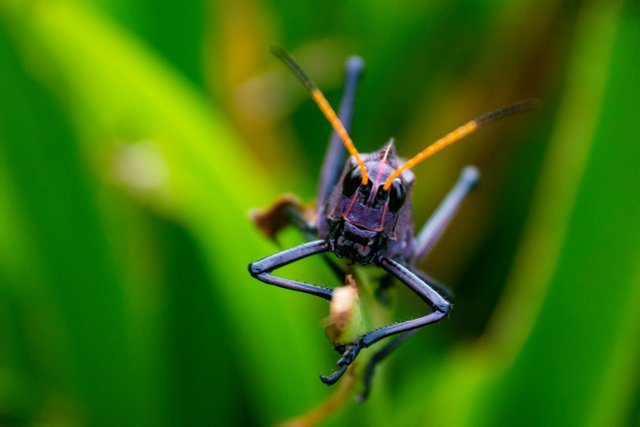
(Photo by Robin Canfield on Unsplash)
Some insects can “smell” cancerous cells, possibly leading to new devices for early detection.
Nothing beats a natural nose. Since the early 1980s, researchers have been trying to develop electronic noses, devices that can detect unique airborne chemical signatures, yet anything on the market or even in the lab can’t compete with evolution. Anything produced by humans just can’t match the complexity produced by billions of years of natural selection. So, researchers from Michigan State University have turned to insect noses in their attempt to create a device to detect cancer earlier than ever before.
In a new study published in the journal bioRxiv, the researchers successfully used the brains and antennae of locusts to detect cancer. It’s thought that cancerous cells change the host’s metabolic process, which alters the volatile organic compounds (VOCs) in the breath, and locusts’ neurophysiology seems particularly sensitive to these changes. By connecting the locusts’ brains and antennae to an electrophysiology platform and using the computational rules to translate between neurons and circuitry, they saw that locusts responded differently to the VOCs from cancerous cells. In fact, the locusts were so sensitive that they could also tell the difference between types of cancer.
The researchers claimed their “results demonstrate that three different human oral cancers can be robustly distinguished from each other and from a non-cancer oral cell line by analyzing individual cell culture VOC composition-evoked olfactory neural responses in the insect antennal lobe.”
Though the team only focused on 3 types of mouth cancers, they are confident the same process could easily be expanded to most other forms of cancer, detected perhaps with other insects. In fact, the team has already had some success with honeybees detecting lung cancer. They believe their method is far superior to similar ideas, as it uses the natural olfactory components, rather than trying to artificially recreate them.
The end goal is to create easy to use, cheap, portable, and fast devices to radically upgrade cancer detection. By incorporating the locusts’ actual biological parts into the device, the average person would be able to take advantage of their highly-evolved ability to distinguish healthy exhalations from those with altered VOCs. They believe such devices would have a response time of 250 milliseconds and could work in virtually any environment, upgrading our early detection abilities and saving millions of lives.
Early detection is the key. More than 10 million people die of cancer each year globally, 600,000 in the US alone, making it the second leading cause of death behind heart disease. The most deadly forms are lung, colorectal, pancreatic, breast, prostate, and liver cancers. Fortunately, most forms are in decline due to healthier lifestyle choices and, most importantly, early detection, though pancreatic and liver cancers are on the rise. A report from Cancer.org claims that “Large reductions in smoking and earlier cancer detection have contributed to steady declines in cancer mortality since the early 1990s, averting an estimated 3.2 million cancer deaths.”
Because of this, many scientists have been racing to not only educate the public about avoiding smoking, obesity, physical inactivity, and other other high risk factors but to also develop better early detection methods. Today’s common methods like radiology, endoscopies, and biopsies can be invasive, expensive, inaccurate, or unable to detect cancer early enough, leaving millions with undiagnosed cancers. The team from Michigan State University might be on the cusp of changing all that, though they caution the actual devices could still be years away.
Originally published at http://thehappyneuron.com on August 19, 2022.